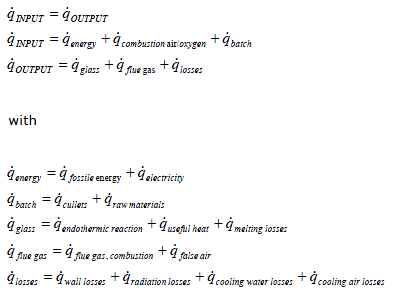Energy & Mass Balances
With the experience on a large variety of furnaces it is possible to forecast possible variations mainly focusing on the fuel consumption, such as:
- Electricity vs. Fuel as well as fuel changes
- Batch and/or glass changes or Heat recovery modifications
- Production increase (with additional electricity or oxygen)
- Conversion from air fuel to oxy fuel combustion (or vice versa)
- Recuperator or regenerator repairs
All these forecasts are based on heat and mass balances according to the most common enunciation of the first law of thermodynamics, that the increase in the internal energy of a thermodynamic system is equal to the amount of heat energy added to the system minus the work done by the system on the surroundings. The overall heat and mass balance of any glass melting furnace can be described as

The accuracy of the forecast is much depending on the base case and the type of variation or forecast respectively, where the base case can be an existing furnace with given data or even a new furnace design with only assumptions.
Based on an existing furnace, knowing all input variables, a forecast is very accurate. The fundamental idea behind is that with the given parameters the overall losses, as described above, can be calculated very quickly without evaluating the furnace refractory conditions etc. in detail. Within a specific forecast these losses will not change significantly. Even when the given parameters are not 100% correct, the forecast or trend respectively will be very accurate anyhow.
Cullet Ratio
It is well known that increasing the cullet ratio reduces the amount of energy required significantly. Assuming a furnace for 300 t/d of typical container glass, per 10% of cullet, the energy consumption can be reduced by about 4-5%.
Cullet Preheating
One way to reduce the energy consumption is to introduce cullet and/or batch preheating. Assuming the same furnace as above with a typical cullet ratio of 60%, per 100 °C, the energy consumption can be reduced by about 2-3%.
Water content in the batch
Water in the cullet is typically introduced to the batch to prevent from carry over with typical volumes of 2-3%. Per 1% of water less in the batch, the energy consumption can be reduced by about 1.5%.
False Air
False air is not wanted, but always involved. False air has a very important influence on the energy consumption. 1% less oxygen content in the flue gas results in 6.0% of energy savings.
Local conditions
There is an influence of the local conditions such as altitude, temperature, barometric level or air humidity of a given production line. The Knowledge of those parameters helps to best determine the reference / basic case. The better the base case is the better is the forecast.

